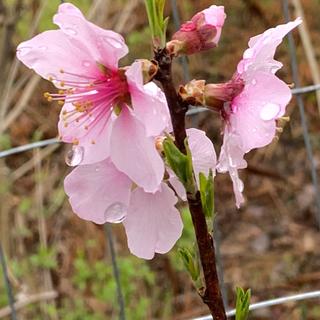Hall's Hardy Almond Tree
Description
Pretty and productive. Large, hard-shell nuts give way to bittersweet kernels. This attractive tree yields large crops of crunchy almonds in fall, and its lovely pink flowers make it a landscape standout in spring. Grows wherever peaches thrive. Matures to be 15–20' tall, 10–15' wide. Ripens in late September. Self-pollinating.
Survival Guaranteed!


Since 1816, Stark Bro’s has promised to provide customers with the very best fruit trees and plants. It’s just that simple. If your trees or plants do not survive, please let us know within one year of delivery. We will send you a free one-time replacement, with a nominal shipping fee of $9.99. If the item in question is not available, we can issue a one-time credit to your account equaling the original product purchase price or issue you a refund. Read more about our warranty policy.
Characteristics
| Bloom Color | Pink |
| Bloom Time | Late |
| Chill Hours | 600 - 800 |
| Fruit Color | Brown |
| Fruit Size | Large |
| Hardiness Zone Range | 5 - 8 |
| Pollination | Self-Pollinating |
| Ripens/Harvest | Late September |
| Shade/Sun | Full Sun |
| Soil Composition | Loamy |
| Soil Moisture | Well Drained |
| Soil pH Level | 6.0 - 7.0 |
| Texture | Crisp, Crunchy |
| Years to Bear | 2 - 3 |
Size & Spacing
Mature Size
Recommended Spacing
Zone Compatibility
Pollination
This variety is self pollinating.
Tools & Supplies
Planting & Care
Learn all about how to grow almond trees in The Growing Guide. An entire section of our website dedicated to your growing success.
Shipping Information
Arrives when it's time to plant
Questions & Answers
My Mom and I purchased a Hardy almond the smaller sized one last year. Arrived well packaged! Moist and just cleaned off the packaging and let the roots set in a bucket of water before planting. Thank God! We followed the instructions and they BOTH have fruit on them. Living in Southern California makes them easier to thrive in the sunny area. We are happy customer's ♡
This variety happens to be a cross between an almond and a peach, resulting in a hardier tree with bittersweet almond kernels. You'd have to consume a fairly large amount of kernels to be affected by the prussic acid, but many growers recommend playing it safe and boiling the kernels anyway.
They do not need to be boiled. They can be eaten fresh , dried or roasted. Apples seeds and almonds have very low level of organic Cynide which gives the slight bitterness. This is different from elemental cyanide which is toxic.
I have mine in a 15-gallon pot. It is 4 years old and just produced its first crop of fruit. The tree is about 5.5 feet tall above the pot now. The fruit it produces is smaller than typical, probably because the tree's pot is not large enough for a root system that would support full sized fruit. The seeds are about .5 inch in length and the nut inside is considerably smaller than that at about .37 or 12/32 inch in length (just over a 1/4 inch).
Yes, to be true-to-name, these almond trees are grafted. We typically use peach rootstocks like Lovell.
It sounds like the issue could be injury caused by the sudden changes in temperature during the daytime and nighttime in winter. You may want to paint the trunk of your tree, below the lowest branch, with a 50/50 mixture of water and white latex paint. This will help reflect the heat rather than absorb it and reduce the risk of winter injury.
I've had a Hall's Hardy Almond tree in my garden for over 10 years now. I get a light greenish-yellow fall leaf color most years but occasionally a true yellow. The spring blooms are breath taking & we get a nice little crop of almonds (after the squirrels steal some) that we roast with salt - delicious!. This tree has been one of my best garden purchases!
Hi, I am in the 5b zone. I am on my third try planting the Hardy almond. The first planting did not survive our weather. The second planting did not survive an accidental chemical overspray :0 and the last tree standing did not survive a kids 4 wheeler. It even had nuts that year! But I am hopeful and bought 2 more this spring to plant again. This will be my last attempt...we will see how it goes. I am moving them to a more protected area and see if that helps. We are on the plains of Kansas and the winds are brutal (40-60 MPH) and drastic climate changes (107 summers to -40 winter chill) our trees really have to be "Hardy"!
It helps to soak almonds in water for 2-4 hours and rinse to remove carrageenan. Then you can roast them for better flavor. Store nuts in refrigerator or freezer to keep them from becoming rancid
I'm in Mass, I have had Hall's for about 6 years. The tree will grow in almost any soil except excessive wet. Some years I get a tree full of almonds and other years no too many, I think it's from the spring weather conditions, flowering & pollination that make the difference... You climate some be better than mine for this tree.

 Options
Options









First order was because the cold killed the one I purchased last year. This one is to replace the one I just purchased that our new puppy dug up and ate!
Self pollinating
hardiness
I wanted to experiment growing/producing these almonds in a 25gal pot. Zone 6a